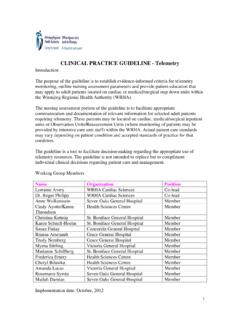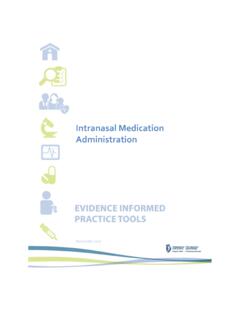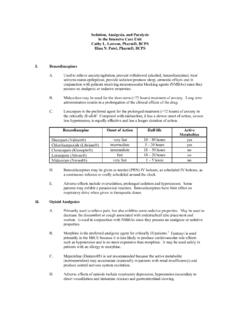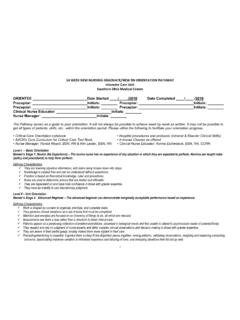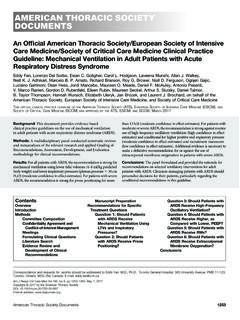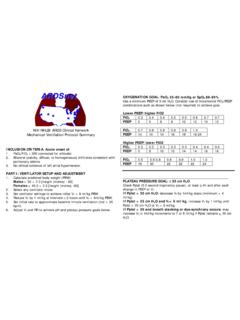Transcription of Title: Peripheral Nerve Stimulator: Train of Four ...
1 CLINICAL PRACTICE GUIDELINE Title: Peripheral Nerve Stimulator: Train of Four Monitoring (Adult) Approval Date: March 2016 Pages: 1 of 7 Approved By:Standards Committee Professional Advisory Committee Supercedes: PURPOSE: To assess the depth of neuromuscular blockade , ensure proper dosing, and minimize side effects when neuromuscular blocking agents (NMBAs) are used. DEFINITIONS: neuromuscular Blocking Agents (NMBA)s Drugs classified as neuromuscular blocking agents that are given to block musculoskeletal activity resulting in paralysis. These agents can be nondepolarizing and depolarizing in nature. Supramaximal Stimulation (SMS) The level at which additional stimulating current elicits no further increase in the intensity of the four Peripheral Nerve twitches.
2 This is a baseline determination that helps establish adequate stimulating current and improves reliability of testing (see ). Train of Four (TOF) Used to describe the pattern of electrical Nerve stimulation and evaluate the degree of neuromuscular blockade . After delivery of four successive stimulating currents to a select Peripheral Nerve with the Peripheral Nerve stimulator (PNS), the number of twitches correlates with the degree of neuromuscular blockade . Table 1: Train of Four Stimulation as a Correlation of Blocked Nerve Receptors TOF (Number of Twitches) Percent of Receptors Blocked 0/4 100 1/4 90 2/4 85 3/4 80 4/4 75 or less GUIDELINES: Registered Nurses in all ICU s within the WRHA Adult critical care Program, all ICUs within the WRHA Cardiac Sciences Program, and the Post-Anesthesia care Units of the Health Sciences Center and St.
3 Boniface Hospital, who have been orientated to equipment and upon a written order from a physician, may perform TOF monitoring. Performance of TOF requires advanced knowledge and skill. Ensure administration of adequate analgesia and sedation prior to the use of NMBA. critical care : Peripheral Nerve STIMULATOR Train OF FOUR MONITORING (ADULT) Page 2 of 6 Peripheral Nerve stimulation (TOF testing) may be indicated to determine the depth of neuromuscular blockade for the following: Initial Endotracheal (ETT) intubation Facilitating mechanical ventilation in patients with severe lung injury Reducing intracranial pressure (ICP) Shivering, including targeted temperature management Severe muscle spasms associated with seizures, tetanus, drug overdose Status epilepticus Facilitation of diagnostic or therapeutic procedures Potential situations in which testing reliability may be limited.
4 Electrolyte imbalances ie. Hypokalemia, hypocalemia, hyponatremia, hypermagnesemia Hypothermia Drug interactions ie. anaesthetics, aminoglycoside antibiotics, magnesium, and calcium channel blockers may potentiate blockade ; corticoidsteroids, theophylline and anticonvulsants may antagonize blockade Neurological and muscular disease ie. muscular dystrophy, multiple sclerosis, myasthenia gravis Contraindications to Peripheral Nerve stimulation (TOF testing) may include the following: No NMBA in use Unstable bone fractures Complications of TOF testing and NMBA use: Discomfort or tingling during testing Side effects related to NMBA use includes: residual muscle weakness, neuropathy,cardiovascular instability, increase risk for DVT, malignant hyperthermia, respiratory compromise, and apnea.
5 If patient is assessed to have 0/4 twitches, troubleshooting is to be performed before assuming 100% NMBA blockade (see ). The following PNS settings: Single Twitch , Tetany/Tetanus or Double Burst are not recommended for this indication. EQUIPMENT: Peripheral Nerve stimulator Two pre-gelled electrode pads (the same as is used for electrocardiography monitoring) Two lead wires packaged with the Peripheral Nerve stimulator Alcohol pads for skin degreasing and cleansing critical care : Peripheral Nerve STIMULATOR Train OF FOUR MONITORING (ADULT) Page 3 of 6 Scissors/clippers for hair removal if necessary PROCEDURE: Site Determination and Preparation Review the physician s order for the number of twitches desired and the best location for testing.
6 PNS can be performed with either ulnar, facial, or posterior tibial Nerve sites. The ulnar Nerve site is recommended, when possible (see , and ). Ensure the site is clean, dry, shaved/clipped, nonedematous, and free of an intravenous or intra-arterial line. Cleanse skin and degrease using alcohol pads. Allow skin to dry. Place pre-gelled electrode pads on desired site. Electrodes are to be changed every 72 hours or as needed. Whenever possible, determine the SMS level before initiating NMBAs. Determining the Supramaximal Stimulation (SMS) Prior to NMBA Use Select the current necessary: If PNS has a dial of current settings (0 to 9 or 10), initially set the dial to 3, then increase the dial by one until four twitches are observed.
7 OR If PNS has a dial to control mili Amp (mA) (0 to 50 mA), initially set the dial to 5 mA, then increase the mA in increments of 5 mA until four twitches are observed. Note the dial setting, or the amount of current (in mA) that corresponds to four vigorous twitches. Administer one to two more TOF stimuli at the same setting in order to confirm the response. This current will then be used in TOF testing for that site. For example: If a strong response is observed when the dial is at 3 or 15 mA, raise the dial by 1 or current to 20 mA. If no increase is seen in intensity of the twitch, the SMS is 3 or 15 mA.
8 If an increase in intensity is seen, raise the mA by dial increments of one or 5 mA until the intensity shows no further increase to determine the SMS. Determining the TOF Response During NMBA Use Test the TOF prior to every bolus dose, and prior to making infusion rate changes. Retest the TOF 10 to 15 minutes after administration of a bolus dose or a change in the continuous infusion of a NMBA . If more than one or two twitches occur and neuromuscular blockade is unsatisfactory for clinical goals, increase the infusion rate as prescribed and retest in 10 to 15 minutes (See Table 1). Patients may demonstrate subtle movement of the extremities with an acceptable TOF response.
9 Retest every 4 hours to ensure satisfactory level of blockade is maintained to meet patient goals of care . critical care : Peripheral Nerve STIMULATOR Train OF FOUR MONITORING (ADULT) Page 4 of 6 Electrode and Lead Placement for Testing the Ulnar Nerve Site Extend the arm, palm up, in a relaxed position. Apply the two pre-gelled electrodes over the path of the ulnar Nerve . Place the distal electrode on the skin at the flexor crease of the ulnar surface of the wrist, as close to the Nerve as possible. Place the second electrode approximately 1-2 cm proximal to the first, parallel to the flexor carpi ulnaris tendon.
10 (From Wiegand, D. L. M. (Ed.). (2011). AACN procedure manual for critical care (6th ed.). St. Louis, MO: Saunders) Determine twitching of the thumb and count number of twitches. Do not count finger movements, only movements of the thumb. Finger movement indicate muscle not Nerve stimulation. Muscle stimulation does not reflect the effectiveness of NMBA. Electrode and Lead Placement for Testing the Facial Nerve Site Place one electrode on the face at the outer canthus of the eye and the second electrode approximately 2 cm below, parallel with the tragus of the ear . (From Wiegand, D. L. M. (Ed.). (2011).)




